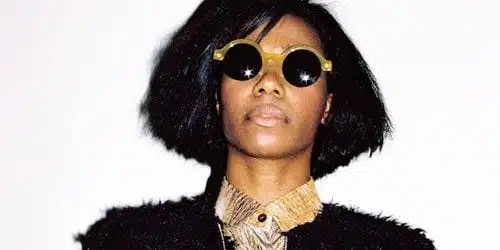
In the mercurial hyper-reality of internet music culture, four years can feel like an eternity. Yesterday’s over-hyped ‘next big thing’ quickly becomes today’s snarky punchline — think Lana Del Ray — or simply falls victim to our ever shortening memories and attention spans. Four years ago, Santi White’s debut album as Santogold, with the impossibly catchy hooks of “L.E.S. Artistes” and “Lights Out”, rode a wave of internet adulation to near universal critical and popular acclaim. Her free-spirited blend of punk attitude and new wave guitars with reggae bass and hip-hop beats firmly established her place within a lineage of genre blurring, party rocking women from Debbie Harry to Gwen Stefani, and MIA. And then there was her voice — deep and mesmerizing with just a touch of rasp, equally suited to riot grrrl shouts, emotionally resonant melodies and those perfectly crafted choruses.
Although Santogold was White’s first album as a solo artist, she was no neophyte within the worlds of popular and independent music. She’d worked for years as an A&R rep for Epic Records, written and produced for an eclectic and boundary pushing pop album in Res’s How I Do, and fronted the Philadelphia punk band Stiffed. Given her considerable resume, it’s no surprise that Santogold played more like a greatest hits album than a debut. And as is often the case for artists who emerge fully formed in this way, it all adds up to a lot of pressure to repeat the successes of their initial offerings and avoid the proverbial sophomore slump. In the years that have passed since Santogold dropped, sites and platforms like Twitter, Tumblr and Spotify, along with countlessly proliferating music blogs, have altered the ways that we discover, share and consume music. And the esoteric blend of artful genre hopping and neon ‘80s cribbing visuals that White once owned so fully has been co-opted in different ways by a range of mainstream artists from Rihanna to Gaga to Nicki Minaj. For her part, White has spent this time touring incessantly, collaborating with a range of hip-hop artists including Pharrell Williams, Kanye West and the Beastie Boys and enlisting an all-star cast of producers and song writing partners for her new album as Santigold, Master of My Make-Believe.
White’s music has always perched precariously on the boundaries between indie and mainstream music culture, and it’s a position she embraces fully on this album. Nowhere is this clearer than on the opening track “Go” which pairs producers Q-Tip and Switch with 2/3 of the Yeah Yeah Yeahs in guitarist Nick Zinner and Karen O. The song’s chorus proclaims “People wants my power / And they want my station … Try to pull my status / But they couldn’t fake it”, over a driving, reverb drenched electro beat. It might be a shout-out to all those top 40 copycats mentioned earlier, or it might be an allusion to the current state of global unrest and uprising. Either way, it sets the tone for an album that is unrelenting, confrontational and bold in the ambitious scope of its vision, despite its meager 38-minute running length.
Those twin themes of confrontation and collapse that emerge in “Go”, are carried to their fullest expression on two of the albums most immediately striking songs. On “Look at These Hoes”, White takes a shot at any would be competitors, rapping “Look at these hoes / These bitches ain’t fuckin’ with me, killah” over a glitchy, otherworldly hip-hop beat produced by Diplo and Boys Noize. And on the lush and gorgeous indie ballad “The Keepers”, she sings “We’re the keepers / While we sleep in America / Our house is burning down” in the most overtly political statement on the album. These two songs also represent the widely varied musical terrain that the album explores. On one end of the spectrum, there is the futuristic, beat driven territory of tracks like the fierce and frenetic “Freak Like Me”, and “Big Mouth”. And on the other, there are the epic indie rock collaborations with Zinner from the Yeah Yeah Yeahs and TV on the Radio’s David Sitek including “This Isn’t Our Parade”, and the pensive, world weary beauty of “The Riot’s Gone”. And then there’s the single “Disparate Youth”, a Ricky Blaze produced ear worm that would feel right at home on a playlist along side a JT/Timbaland R&B jam if it weren’t for Zinner’s occasional burst of angular guitar stabs. There are few artists out there who could pull off this kind of balancing act, but Santigold’s greatest strength lies in the rich diversity of her sonic palette, and she delves deep into that vast range of creative sources throughout this album.
Perhaps because there are no instantly gratifying individual tracks on the level of an “L.E.S. Artistes” on this album, the initial critical responses to Master of My Make-Believe have often been lukewarm at best. Or perhaps it’s because of the fickle nature of an internet music culture that set expectations for this album unreasonably high, which was surely exacerbated by the amount of time it took for it to see the light of day. At any rate, I’m guessing that this will be a grower for many fans and critics who might dismiss it as somehow lacking upon first listening. I would place this album among the strongest work coming out in both the realms of indie and pop music these days, and though it may not inspire the level of critical and popular veneration that her first album enjoyed, it’s a welcome return by one of the most inventive and inspired recording artists working today.

